| Town class Light
Cruisers |
| |
| The Town
class of light cruisers were built in 3 distinctive
sub-classes, the Southampton, Gloucester and
Edinburgh classes |
| Black and
white photos sourced from the Royal Navy Ships of Victor
Johns |
| |
| Pictures of Town
class Light Cruisers |
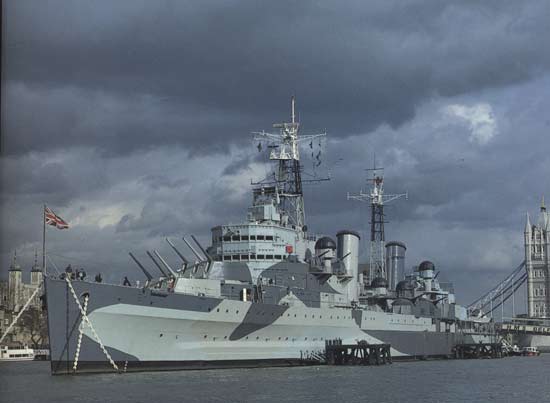 |
HMS Belfast as she was
converted on the 1960's, and is today in the Pool of
London. The Black
capped directors are MRS.1 Barrage Directors for the
Light AA guns. From the HMS Belfast
Official Museum Website. |
 |
| Birmingham, in WW2
camouflage. |
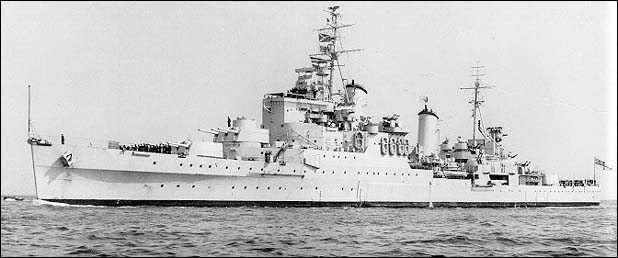 |
| Glasgow, with the Group 1
superstructure. Pom-pom AA is mounted on top of the
hangar. |
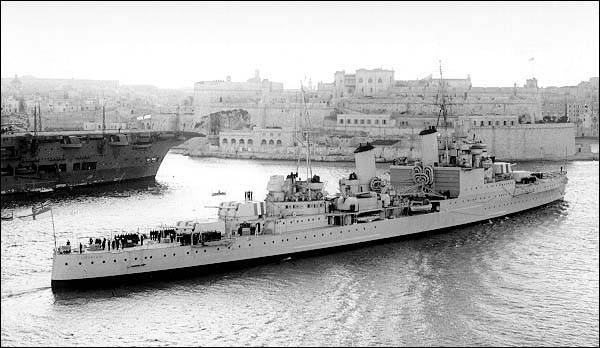 |
| Liverpool in Malta, 1939.
Note hangar doors and twin 4" AA guns ( amidships ) |
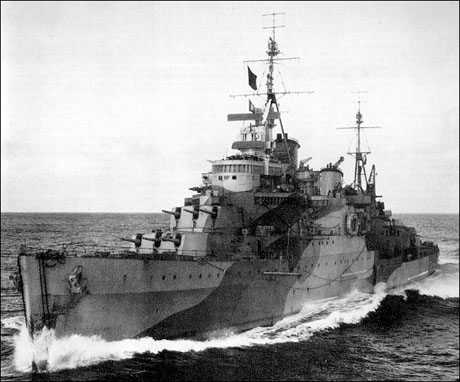 |
| Liverpool, with the Group
2 superstructur, 1942 |
 |
| Liverpool. |
 |
| Newcastle. |
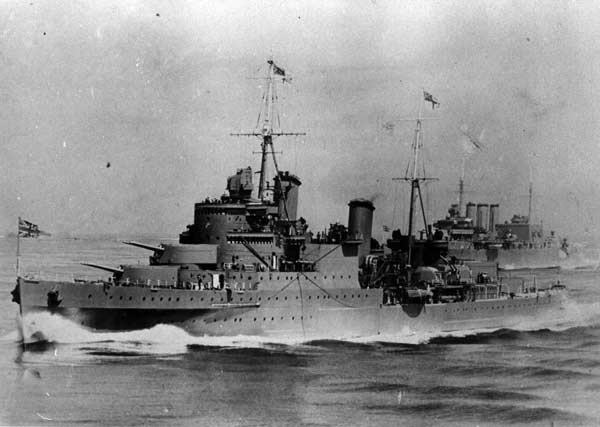 |
| Sheffield. |
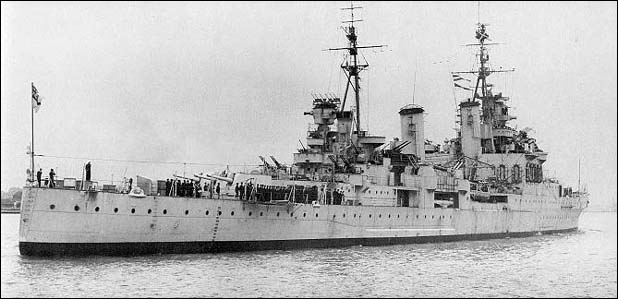 |
| Sheffield in 1942, with
extensive light AA armament and AA directors added. |
| |
| Individual
Specification |
| Name |
Pennant |
Commisioned |
Builders |
| Newcastle |
C76 |
5 Mar. 1937 |
Vickers Armstrong |
| Southampton |
n/a |
6 Mar. 1937 |
John Brown |
| Sheffield |
C24 |
25 Aug. 1937 |
Vickers Armstrong |
| Glasgow |
C21 |
9 Sep.1937 |
Scotts |
| Birmingham |
C19 |
18 Nov. 1937 |
Devonport RDY |
The "Town" Class cruisers were built
in response to the Japanese "Mogami" Class (initially
armed with 15 x 6.1" guns) and the American
"Brooklyn" Class (15 x 6"). A smaller armament of
12 x 6" guns was accepted, partly because of the
ever-present need to produce numbers of ships, which necessitated
a reduction in size, and partly because more guns than this were
considered unnecessary.
They were the first British cruisers to be designed with integral
aircraft hangars (one being built into the forward superstructure
either side of the forefunnel) and a fixed, cross-deck catapult.
The main armament was mounted in the new Mk.XXII turret, the guns
having a designed rate of fire of 12rpm. In practice the rate of
fire was about half this figure, but it still gave the ships the
capacity to smother a target with about 70 6" shells a
minute.
Sheffield was one of the first British ships to be fitted
with a surface-search radar, which she put to good use in
shadowing the German battleship Bismarck.
The ships served in all theatres of WW2, but despite the amount
of action they saw only one - Southampton - was lost.
In 1944 the other four ships had X-turret and all aircraft
equipment removed to reduce topweight and allow for the fitting
of additional close-range weapons.
Birmingham and Newcastle were extensively
modernised in 1950-52, bring given a new rounded bridge, lattice
foremast, improved radar and fire-control systems, and a uniform
close-range armament of 40mm guns. Sheffield was similarly
modernised in 1956-57.
| Dimensions |
Net displacement |
9100 tons |
Length |
591.5' |
| Gross
displacement |
11350 tons |
Beam |
61.75' |
| Load |
2250 tons |
Draught |
17' |
| Performance &
Propulsion |
| Range |
12000 miles @ 12 knots |
Speed |
32 kts |
| Propulsion |
4 x Admiralty 3-drum boilers, 4 x
Parsons steam turbines @ 72000 hp |
| Armament,
Armour & Complement |
| Complement |
750 Officers & Ratings |
Aircraft |
2 x Supermarine Walrus |
| Armament |
- Gun
- 4~3
x 3 x 6" / 50 Mk.23
- 4 x
2 x 4' / 45 QF Mk.16 HA
- 2 x
4 x 2 pdr "Pom-Pom" AA
- 2 x
4 x 0.5" MG's
- Torpedo
- 2 x
3 x 21" tubes Later, Kent
only
|
Armour |
- 4.5"
main belt
- 1.5"
deck
- 1" -
4.5" magazines
- 2.5"
bulkheads
- 1"
turrets
|
| Close Range
Armaments |
| |
1945 |
1957 |
| Birmingham |
- 4 x 4 x 2pdr pom-pom AA
- 2 x 4 x 40mm AA
- 11~18 x 20mm AA
|
- 6 x 2 x 40mm AA
- 6 x 1 x 40mm AA
|
| Glasgow |
- 8 x 4 x 2pdr pom-pom AA
- 11~18 x 20mm AA
|
- 6 x 4 x 2pdr pom-pom AA
- 8 x 1 x 40mm AA
|
| Newcastle |
- 4 x 4 x 2pdr pom-pom AA
- 11~18 x 20mm AA
|
- 6 x 2 x 40mm
- 6 x 1 x 40mm
|
| Sheffield |
- 4 x 4 x 2pdr pom-pom AA
- 2 x 4 x 40mm AA
- 11~18 x 20mm AA
|
- 8 x 2 x 40mm
- 2 x 1 x 40mm
|
| Service
Histories |
| Birmingham |
- Home Fleet, South Atlantic and
Eastern Fleet 1939-43
- Mediterranean 1943 - severely
damaged by a torpedo 28 November
- under repair until Jan. 1945
- Home and East waters 1946-49
- modernisation 1950-52
- 5th Cruiser Squadron in
Far East 1952-56
- Korean War service 1952
- Home and Mediterranean Fleets
1956-59
- paid off 1959; broken up at
Inverkeithing 1960.
|
| Glasgow |
- Home Fleet 1939-40 - sank
destroyer Imogen in collision 16 Jul. 1940
- Eastern Fleet 1940-41 -
accidentally sank Indian ship Prabhavati 9
Dec. 1941
- Mediterranean Fleet 1942-43
- Home Fleet 1943-44
- with Emerald sank
German light destroyers T.25, T.26
and Z.27 in English Channel 28
Nov. 1943
- damaged by shore batteries off
Normandy 26 Jun. 1944
- flagship of 5th Cruiser
Squadron in East Indies Sep. 1945
- flagship of 4th Cruiser
Squadron in East Indies Sep. 1946
- refits
- West Indies and flagship of
Mediterranean Fleet and Flag Officer (Flotillas)
Home Fleet 1947-1956
- paid off into reserve at
Portsmouth 1956; broken up at Blyth 1958.
|
| Newcastle |
- North Atlantic patrols and convoy
escort Sep. 1939 to mid-1940
- refit, then to Home Fleet
- with Emerald and 5th
Destroyer Flotilla engaged German destroyers in
English Channel 17 Oct. 1940
- dash to Malta with aviation fuel,
stores and personnel Nov. 1940
- departed Malta with Force
"D" - battleship Ramillies,
heavy cruiser Berwick and light cruiser Coventry
- Joined Force "H" 26 Nov.
1940
- Battle of Cape Spartivento 27 Nov.
1940
- South Atlantic patrols 1941 -
spent only 5 24-hour periods in port in 10 months
- intercepted blockade-runner Erlangen
24 Jul. 1941
- refit at Boston N.Y. Sep.-Dec.
1941
- joined Home Fleet 29 Jan. 1942
- assigned to Eastern Fleet as
flagship of 4th Cruiser Squadron Feb.
1942
- joined Eastern Fleet at Bombay
Apr. 1942
- detached to Mediterranean to
support "Vigorous" convoy 27 May 1942
- torpedoed by E-boat 15 Jun. 1942
- to Brooklyn N.Y. for repairs
- arrived Devonport 16 Dec. 1942 -
further modifications to fire-control systems
- joined Home Fleet at Scapa Flow
Mar. 1943
- escorted "round the
Cape" convoy Apr.-May 1943
- rejoined Eastern Fleet at
Kilindini 27 May
- with escort carrier Battler,
cruisers Suffolk and Kenya, AMC Canton,
2 destroyers and a frigate searched Indian Ocean
for tankers refuelling U-boats - sank Charlotte
Schliemann and Brake
- rejoined Eastern Fleet at
Trincomalee Mar. 1944
- drydocked at Simonstown Apr.-Sep.
1944
- rejoined Eastern Fleet as flagship
of 5th C.S. Oct. 1944
- supported British Army in Burma;
drydocked at Colombo Feb. 1945
- arrived Sydney, Australia, Jun.
1945 to join British Pacific Fleet - not wanted
- returned to UK escorting transport
Empress of Scotland
- Home Fleet 1946-48
- paid off 1948
- modernised 1950-52
- Far East and Mediterranean service
1952-58
- paid off 1958
- broken up at Faslane 1959.
|
| Sheffield |
- Home Fleet and Mediterranean
1939-45 - hunt for Bismarck May 1941
- Battle of North Cape 26 Dec. 1943
- three commissions as flagship of
America and West Indies Station and one
commission as flagship of Heavy Squadron 1946-56
- modernised 1956-57
- Home and Mediterranean Fleets
1957-60
- paid off 1960
- flagship of Reserve Fleet 1960-67
- broken up at Faslane 1967.
|
| Southampton |
- Home Fleet 1939-40
- Mediterranean Fleet 1940-41
- heavily damaged by air attack 10
Jan. 1941
- abandoned the next day and sunk by
torpedoes from Gloucester and Orion.
|
| Individual
Specification |
| Name |
Pennant |
Completed |
Builders |
| Liverpool |
C11 |
2 Nov. 1938 |
Fairfield |
| Manchester |
n/a |
4 Aug. 1938 |
Hawthorn Leslie |
| Gloucester |
n/a |
31 Jan. 1939 |
Devonport RDY |
These three ships were modifications of the
original Southampton design, with improved fire-control
equipment which included a second main-armament director aft.
They had a new, streamlined bridge front, and being 300 tons
heavier than the first group, were 8" wider and required
more powerful machinery to attain the required 32 knots.
They served mainly in the Mediterranean, where two were lost; the
third, Liverpool, spent much of the war under repair from
combat damage, and during her final period in dockyard hands in
1942-43 she had her X-turret removed
| Dimensions |
Net displacement |
9400 tons |
Length |
591.5' |
| Gross
displacement |
11650 tons |
Beam |
62.25' |
| Load |
2250 tons |
Draught |
17.5' |
| Performance &
Propulsion |
| Range |
12100 miles @ 12 knots |
Speed |
32.25 kts |
| Propulsion |
4 x Admiralty 3-drum boilers, 4 x
Parsons steam turbines @ 82500 hp |
| Armament,
Armour & Complement |
| Complement |
800 Officers & Ratings |
Aircraft |
2 x Supermarine Walrus |
| Armament |
- Gun
- 4~3
x 3 x 6" / 50 Mk.23
- 4 x
2 x 4' / 45 QF Mk.16 HA
- 2 x
4 x 2 pdr "Pom-Pom" AA
- 2 x
4 x 0.5" MG's
- Torpedo
|
Armour |
- 4.5"
main belt
- 1.5"
deck
- 1" -
4.5" magazines
- 2.5"
bulkheads
- 2" -
4" turrets
|
| Close-Range
Armament - Liverpool |
| 1945 |
1952 |
- 6 x 4 x
2pdr pom-poms
- 2 x 1 x
2pdr pom-poms
- 6 x 2 x
20mm
- 7 x 1 x
20mm
|
- 6 x 4 x
2pdr pom-poms
- 2 x 1 x
2pdr pom-poms
- 2 x 1 x
40mm
|
| Service
Histories |
| Gloucester |
- Home Fleet 1939-40
- Mediterranean 1940-41 - Battle of
Cape Matapan 27 Mar. 1941
- hit by 4 bombs and near-missed by
3 off Crete 22 May 1941
- capsized and sank.
|
| Liverpool |
- Mediterranean 1940 - with 7th
Cruiser Squadron in battle of Calabria 9 Jul.
1940
- hit by air-dropped torpedo in
Aegean Sea 14 Oct. 1940
- under repair until Mar. 1942
- Mediterranean 1942 - torpedoed in
forward engine-room while escorting Malta convoy
14 Jun.
- repairs completed Jul. 1943 but
not recommissioned for war service probably owing
to manpower shortage
- Mediterranean Fleet 1945-52
(flagship 1949-50)
- paid off 1953
- arrived at Bo’ness 2 Jul. 1958
to be broken up.
|
| Manchester |
- Mediterranean Fleet 1940-41 -
Battle of Cape Matapan 27 Mar. 1941
- damaged by air attack while
escorting "Substance" convoy to Malta
Jul. 1941
- Home Fleet 1941-42
- torpedoed by E-boats on night of
12-13 August 1942 while escorting
"Pedestal" convoy to Malta
- abandoned and sunk by scuttling
charges.
|
| Individual
Specification |
| Name |
Pennant |
Completed |
Builders |
Details |
| Edinburgh |
n/a |
6 July 1939 |
Swan Hunter |
Scuttled 2 May 1942 |
| Belfast |
C35 |
3 August 1939 |
Harland & Wolff |
Reserve 1952-56. Refitted 1956-59.
Paid off 1971 to museum ship. |
These ships were further modifications of the Southampton
design, and were originally intended to have four quadruple
6" turrets. However, trails with the prototype quadruple
mount were not successful, and it was decided to revert to the
triple mount of the earlier ships.
They also had an additional pair of twin 4" HA/LA guns, and
the magazines for the 4" guns were moved from abaft the
machinery to forward of it. This in turn meant moving the
machinery aft, resulting in a large gap between the forward
superstructure and the forefunnel, giving the ships a distinctive
silhouette. The after 6" turrets were also mounted one deck
higher than in the "Southamptons". They were quite
startling to look at, with low, sweeping hulls, sharply raked
funnels and masts placed well back and a general look of having
everything shoved back of the superstructure.
Belfast was very nearly lost in the third month of the war
when she struck a mine in the Firth of Forth. The resulting
damage was extensive - the keel was broken, the hull distorted
and strained, the machinery severely shock-damaged and the centre
section of the ship flooded. Had it been later in the war she
would probably have been written off as a total loss, but as it
was she underwent repairs that lasted until October 1942.
In late 1944 Belfast had two of her twin 4" guns and
all her aircraft equipment removed prior to her deployment to the
Pacific.
From 1956 to 1959 Belfast underwent a major modernisation,
during which she was given a new bridge, lattice masts, a new
uniform close-range armament of 40mm guns and improved
electronics, and her torpedo tubes were removed.
| Dimensions |
Net displacement |
10260 tons |
Length |
613.5' |
| Gross
displacement |
12675 tons |
Beam |
63.25' |
| Load |
2415 tons |
Draught |
17.25' |
| Performance &
Propulsion |
| Range |
12200 miles @ 12 knots |
Speed |
32.5 kts |
| Propulsion |
4 x Admiralty 3-drum boilers, 4 x
Parsons steam turbines @ 85000 hp |
| Armament,
Armour & Complement |
| Complement |
850 Officers & Ratings |
Aircraft |
3 x Supermarine Walrus |
| Armament |
- Gun
- 4~3
x 3 x 6" / 50 Mk.23
- 6 x
2 x 4' / 45 QF Mk.16 HA
- 2 x
8 x 2 pdr "Pom-Pom" AA
- 2 x
4 x 0.5" Vickers AA
- Torpedo
|
Armour |
- 4.5"
main belt
- 1.5" -
2" deck
- 3"
deck over magazines
- 2.5"
bulkheads
- 2" -
4" turrets
|
| Close-Range
Armament - Belfast |
| 1942 |
Early 1944 |
Late 1944 |
1945 |
1959 |
- 2 x 8 x 2pdr pom-poms
- 5 x 2 x 20mm
- 4 x 1 x 20mm
|
- 2 x 8 x 2pdr pom-poms
- 6 x 2 x 20mm
- 14 x 1 x 20mm
|
- 2 x 8 x 2pdr pom-poms
- 4 x 4 x 2pdr pom-poms
- 4 x 1 x 2pdr pom-poms
- 6 x 2 x 20mm
- 6 x 1 x 20mm
|
- 2 x 8 x 2pdr pom-poms
- 4 x 4 x 2pdr pom-poms
- 4 x 1 x 2pdr pom-poms
- 5 x 1 x 40mm
- 2 x 2 x 20mm
- 6 x 1 x 20mm
|
|
| Service Histories |
| Belfast |
- 18th Cruiser Squadron
in Home Fleet Sep. 1939
- severely damaged by mine in Firth
of Forth 21 Nov. 1939, broke her back
- recommissioned after repairs 3
Nov. 1942 as flagship of 10th Cruiser
Squadron, Home Fleet
- covered convoys to Russia 1943-44
- Battle of North Cape 26 Dec. 1943
- supported Normandy landings Jun.
1944; refit for Pacific service earl 1945
- arrived Sydney Aug. 1945
- repatriation duties Sep. 1945-Jan.
1946
- returned to Portsmouth and paid
off 15 Oct. 1947
- recommissioned 22 Sep. 1948
- joined Far East Fleet as flagship
of 5th Cruiser Squadron Dec. 1948
- Korean War service 6 Jul.-Oct.
1950, Feb. 1951-26 Sep. 1952
- in reserve 1953-56
- major modernisation 1956-59
- Far East 1959-62
- paid off at Devonport 24 Aug. 1963
- arrived in Pool of London to
become museum ship 14 Oct. 1971
- Since 1971 she has been preserved
as a museum ship in the Pool of London.
|
| Edinburgh |
- 18th Cruiser Squadron
in Home Fleet Sep. 1939
- covered Russian convoys 1941-42
- torpedoed by U.456 while
escorting convoy QP-11 30 Apr. 1942
- torpedoed again by German
destroyers off Bear Island 2 May
- sunk by torpedo from destroyer Foresight.
|
| |
| Back |

















